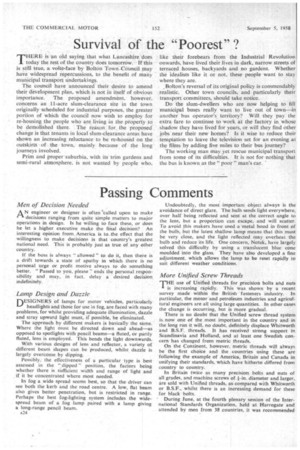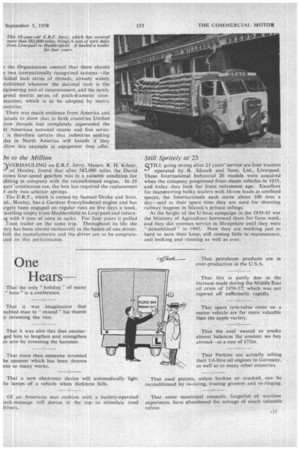Passing Comments •
Page 26

Page 27

If you've noticed an error in this article please click here to report it so we can fix it.
Men of Decision Needed
AN engineer or designer is often 'called upon to make
decisions ranging from quite simple matters to major operations in design. Is he willing to face these, or does he let a higher executive make the final decision? An interesting opinion from America is to the effect that the willingness to make decisions is that country's greatest national need. This is probably just as true of any other country.
If the boss is always " allowed " to do it, then there is a drift towards a state of apathy in which there is no personal urge or profit motive always to do something better. "Passed to you, please " ends the personal responsibility and may, in fact, delay a desired decision indefinitely.
Lamp Design and Dazzle
DESIGNERS of lamps for motor vehicles, particularly headlights and those for use in fog, are faced with many problems, for whilst providing adequate illumination, dazzle and stray upward light must, ir possible, be eliminated.
The approach by different makers is basically the same. Where the light must be directed down and ahead—as opposed to spotlights with pencil beams—a fluted, or partly fluted, lens is employed. This bends the light downwards.
With various designs of lens and reflector, a variety of different beam shapes can be produced, whilst dazzle is largely overcome by dipping.
Possibly,. the effectiveness of a particular type is best assessed in the "dipped" position, the factors being whether there is sufficient width and range of light and if it be concentrated where most needed.
In fog a wide spread seems best, so that the driver can see both the kerb and the road centre. A low, flat beam also gives better penetration, but is restricted in range. Perhaps the best fog-lighting system includes the widespread beam of a fog lamp paired with a lamp giving a long-range pencil beam.
A24 Undoubtedly, the most important object always is the avoidance of direct glare. The bulb sends light everywhere, over half being reflected and sent at the correct angle to the lens, but a proportion can escape, and will scatter. To avoid this makers have used a metal hood in front of the bulb, but the latest shallow lamp means that this must be very close, and the light reflected may overheat the bulb and reduce its life. One concern, Notek, have largely solved this difficulty by using a translucent blue cone moulded into the glass. They have also developed a fine adjustment, which allows the lamp to be reset rapidly to suit different weather conditions.
More Unified Screw Threads
THE use of Unified threads for precision bolts and nuts
is increasing rapidly. This was shown by a recent survey made within the British fasteners industry. In particular, the motor and petroleum industries and agricultural engineers are all using large quantities. In other cases the change is occurring, but is more gradual.
There is no doubt that the Unified screw thread system is now one of the most important in the country and in the long run it will, no doubt, definitely displace Whitworth and B.S.F. threads. It has received strong support in Scandinavia and Holland, and at least one Swedish concern has changed from metric threads.
On the Continent, however, metric threads will always be the first choice and the countries using these are following the example of America, Britain and Canada in unifying their standards, which have hitherto differed from country to country.
In Britain twice as many precision bolts and nuts of all grades, and machine screws of +-in. diameter and larger, are sold with Unified threads, as•compared with Whitworth or B.S.F., whilst there is an increasing demand for these for black bolts.
During June, at the fourth plenary session of the International Standards Organization, held at Harrogate and attended by men from 38 countries, it was recommended
) the Organization council that there should e two internationally recognized systems—the 'riffled inch series of threads, already widely stablished wherever the decimal inch is the rigineering unit of measurement, and the newly greed metric series of pitch-diameter corninations, which is to be adopted by metric ountries.
There was much evidence from America and artada to show that in both countries Unified :sew threads had completely superseded the Id American national coarse and fine series. E is therefore certain that industries seeking Iles in North America will benefit if they allow this example in equipment they offer.
)n to the Million
-VERHAULING an E.R.F.. lorry, Messrs, R. H. Kilner, --' of Hanley, found. that after 582,000 miles the David Irown four-speed gearbox was in a .suitable condition for eating in company with the reconditioned engine. In 19 ears' continuous use, the box has required the replacement
only two selector springs.
The E.R.F., which is owned by Samuel Drake and Sons, ,td., Honley, has a Gardner five-cylindered engine and has irgely been engaged on regular runs on five "days a week, livening empty from -Huddersfield to Liverpool and return1.g with 9 tons of corn in sacks. For four years it pulled 7-ton trailer on the same trip. Throughout its life the 3rry has been almost exclusively in the hands of one driver. loth the manufacturers and the driver are to be congratuIted on this performance.
• Still Spritely at 23
STI" going strong after 23 years' service are four tractors operated by -R. Silcock and Sons, Ltd., Liverpool. These International Industrial 20 models were acquired when the company progressed from steam vehicles in 1935, and today they look far from retirement age. Excellent for rnanceuvring bulky trailers with 16-ton loads in confined spaces, the Internationals each move about 100 tons a day—and in their spare time they are used for shunting railway wagons in Silcock's private sidings.
At the height of the U-boat campaign in the 1939-45 war the Ministry of Agriculture borrowed them for farm work, and they did yeoman service in Shropshire until they were " demobilized " in • 1945. Now they are working just as hard to earn their keep, still costing little in maintenance, and looking and running as well as ever.




































































































